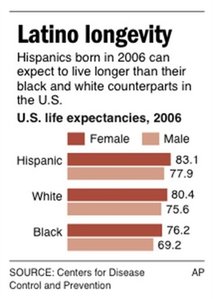| @wehaitians.com | |
No one writes to the tyrants | |
HistoryHeads/Not Just Fade Away |
| Correspond with us, including our executive editor, professor Yves A. Isidor, via electronic mail: |
| letters@wehaitians.com; by way of a telephone: 617-852-7672. |
| Want to send this page or a link to a friend? Click on mail at the top of this window. |
|
 |
|
| A SPECIAL SECTION: Haiti, Since the January 12, 2010 Fierce Earthquake |
Posted Friday, October 15, 2010
| In US, Hispanics outlive whites, blacks by years |
| By Mike Stobbe, |
| AP Medical Writer |
 |
| _____________________________________________________________ |
| Wehaitians.com, the scholarly journal of democracy and human rights |
| More from wehaitians.com |